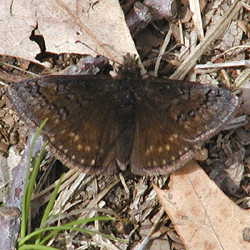Butterfly Atlas
Find a Butterfly
Sleepy Duskywing
Erynnis brizo
Named
Boisduval and Leconte, 1834

Identification
Wingspan: 1 1/8 - 1 5/8". Distinguished from all other duskywings except Dreamy by lack of transparent spots on forewing. Most similar to Dreamy Duskywing, but larger with less grayish scaling on the forewings above and with vertical forewing bands heavier and more continuous. Also, labial palpi do not protrude as distinctly as those of Dreamy. This species begins flying earlier than E. icelus. . Habitat and distribution also aid identification in Massachusetts (See below).
Distribution
Continent wide from northern California and the southern Rockies south to central Mexico and from southeastern Saskatchewan and the eastern edge of the Great Plains east to Prince Edward Island and Florida. In New England it occurs from southernmost Maine and eastern New Hampshire and Massachusetts south following the distribution of its food plant.
Status in Massachusetts
Fairly common to uncommon on the southeastern coastal plain, Cape Cod and the islands and in a few scattered localities away from the coast where there is sufficient scrub oak. Kimball and Jones (1943) characterize brizo‘s status as "common in the scrub oak region" on Nantucket and abundant in the "plains area" of West Tisbury on Martha‘s Vineyard. The lack of Atlas records from Cape Cod and Nantucket may reflect low collector effort early in the season, though other recent observers have noted that the species can be relatively scarce even in the ideal season and habitat. Maximum: 4-6, 12 May 1994, Plymouth (Plymouth Co.).

Flight Period in Massachusetts
A single flight from early May to mid-June; mainly mid May to the first week in June. Extreme dates: April 27, Walpole, Miss Guild, (in Scudder 1889); May 2, 1987, Rehoboth, K. Anderson.
Larval Food Plants
Scrub Oak (Quercus ilicifloia). Uses other small oaks south of New England. In Massachusetts the only other likely host plant would be Dwarf Oak (Q. prinoides) which occurs in the same habitat. Shapiro (1974) reports American Chestnut (Castanea dentata) as a foodplant.
Adult Food sources
Found nectaring on a variety of early spring flowers including cherry, dewberry, cinqufoils, blueberry, azalea, hawkweed, and dandelion during the Atlas period; Scudder (1989) says that "the female is very fond of violet blossoms". Like all Erynnis, brizo "drinks" at puddles and other wet places.

Habitat
Barrens and other places with poor, thin or well drained (often sandy) soils where Scrub Oak thrives. Flies in shrubby areas and openings in oak barrens seldom far from shade.
Life Cycle
EGG: pale green; dome-shaped with 15 prominent vertical ribs with finer raised lateral lines in between; microsculpture of tiny raised points. OVIPOSITION: Eggs are laid singly on young leaves or leaf buds of the food plant, hatching in about 8 days. LARVA: Stout and tapering to both ends. Pale green with a darker stripe down the back bordered by white or yellow and paler stripes along the upper sides; may be tinged with purplish at front and rear; head yellowish to dark brown with orange-yellow spot or spots. The caterpillar feeds from a leaf roll "sewn together" with silk and presumably behaves as described under Dreamy Dusky Wing. CHRYSALIS: "Pea green, paler on the abdomen" (Scudder, 1889); long and cylindrical. PUPAL STAGE: Occurs in a silk-lined leaf roll in the early spring; the mature larva does not eat following hibernation; duration:2-3 weeks. OVERWINTERING STAGE: Fully fed mature larva.
Account Author
Chris Leahy



